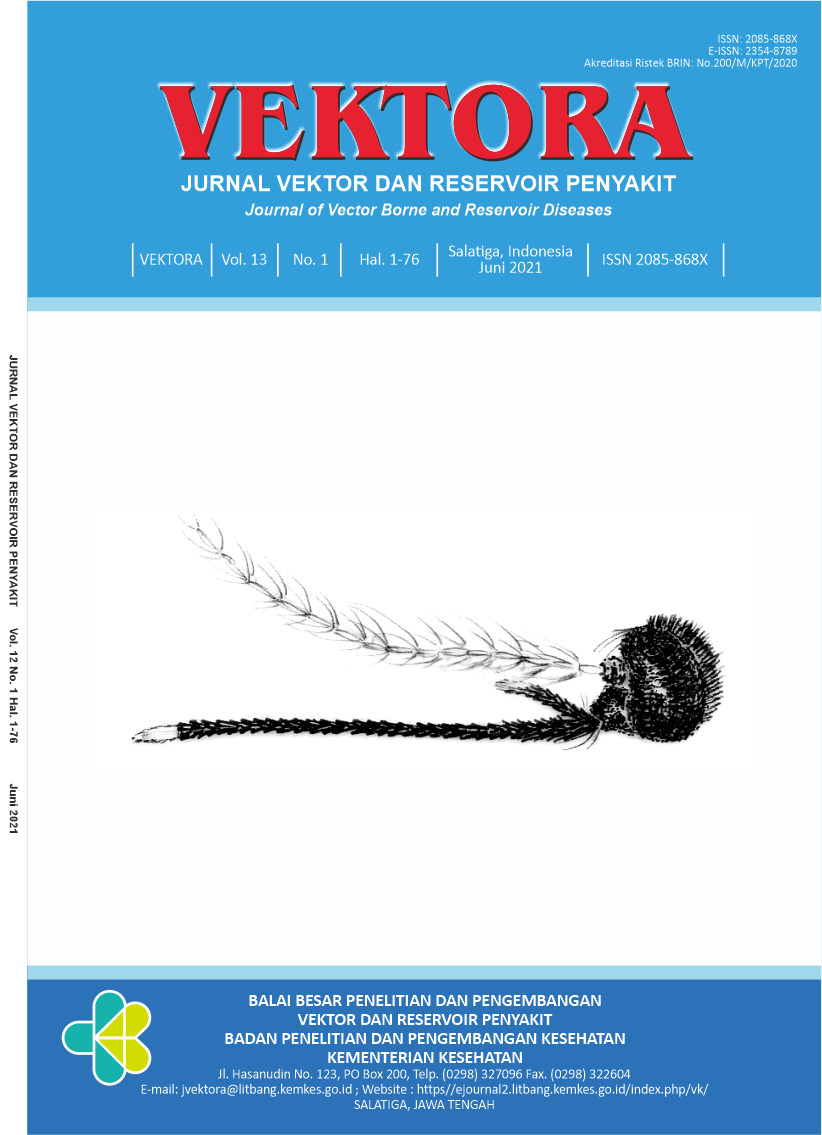RANCANGAN PRIMER UNTUK DETEKSI VIRUS DENGUE SEROTIPE DENV-3 DAN DENV-4 DENGAN METODE NASBA DAN LFIA
PRIMER DESIGN FOR DETECTION DENV-3 AND DENV-4 SEROTYPE DEN-GUE VIRUS USING NASBA AND LFIA METHODS
Abstract
Simple, fast, and accurate early detection is expected to reduce the mortality rate due to dengue infection. The dengue virus RNA detection method using Nucleic Acid Sequence-Based Amplification (NASBA) is an alternative method that can reduce the use of a thermocycler. The detection of NASBA amplicons was carried out using the Lateral Flow Assay (LFIA). This study was conducted to prove the effectiveness of the new primer design to detect dengue virus serotypes DENV-3 and DENV-4. In addition, this study was also conducted to measure the sensitivity and specificity of the LFIA method to detect dengue virus serotypes DENV-3 and DENV-4. The initial stage of this research was the isolation of dengue virus RNA from C6/36 cell cultures, then proceeded to design primers for NASBA and LFIA probes. NASBA reactions were performed on dengue virus serotypes DENV-3 and DENV-4 and DENV-4. The NASBA reaction products were then visualized on LFIA and agarose gel electrophoresis. The NASBA method with a new primary design can be used for the detection of dengue virus serotypes DENV-3 and DENV-4 as evidenced by electrophoresis results bands at 196 bp and 144 bp. The LFIA method with probe design can be used for the detection of dengue virus serotype DENV-3 and DENV-4 dengue virus serotype with a positive line on the test line on LFIA. The LFIA method for the detection of the dengue virus has a sensitivity up to a concentration of 10-3 (1 g/μl). The results of this study indicate that the newly designed primers are specific and sensitive for DENV-3 and DENV-4 dengue virus serotypes detection.
Abstrak
Deteksi dini yang sederhana, cepat dan akurat diharapkan dapat mengurangi tingkat kematian akibat infeksi dengue. Metode deteksi RNA virus dengue dengan Nucleic Acid Sequence-Based Amplification (NASBA) merupakan metode alternatif yang dapat mengurangi penggunaan thermocycler. Deteksi amplikon hasil NASBA dilakukan dengan Lateral Flow Assay (LFIA). Studi ini dilakukan untuk membuktikan efektivitas desain baru primer untuk mendeteksi virus dengue serotipe DENV-3 dan DENV-4. Di samping itu, studi ini juga dilakukan untuk mengukur sensitivitas dan spesifisitas metode LFIA untuk mendeteksi virus dengue serotype DENV-3 dan DENV-4. Tahap awal penelitian ini adalah isolasi RNA virus dengue dari kultur sel C6/36, kemudian dilanjutkan dengan merancang primer untuk NASBA dan probe LFIA. Reaksi NASBA dilakukan pada virus dengue serotipe DENV-3 dan DENV-4 dan DENV-4. Produk reaksi NASBA kemudian divisualisasikan pada LFIA dan elektroforesis gel agarosa. Metode NASBA dengan desain primer baru dapat digunakan untuk deteksi virus dengue serotipe DENV-3 dan DENV-4 yang dibuktikan oleh pita hasil elektroforesis pada 196 bp dan 144 bp. Metode LFIA dengan desain probe dapat digunakan untuk deteksi virus dengue serotipe DENV-3 dan DENV-4 serotipe virus dengue dengan garis positif pada garis uji pada LFIA. Metode LFIA untuk deteksi virus dengue memiliki sensitivitas hingga konsentrasi 10-3 (1 μg/μl). Hasil penelitian ini menunjukkan bahwa primer baru yang dirancang bersifat spesifik dan sensitif untuk deteksi serotipe virus dengue DENV-3 dan DENV-4.
References
Buletin Jendela Epidemiologi, 2010. . Articel.
Deiman, B., Van Aarle, P., Sillekens, P., 2002. Characteristics and applications of Nucleic Acid Sequence-Based Amplification (NASBA). Appl. Biochem. Biotechnol. - Part B Mol. Biotechnol. 20, 163–179.
Fakruddin, M., Mazumdar, R., Chowdhury, A., Mannan, K., 2012. Nucleic acid sequence based amplification (NASBA)-prospects and applications. Int J Life Sci Pharma Res 2, 106.
Guzman, M.G., Halstead, S.B., Artsob, H., Buchy, P., Farrar, J., Gubler, D.J., Hunsperger, E., Kroeger, A., Margolis, H.S., Martí-nez, E., Nathan, M.B., Pelegrino, J.L., Simmons, C., Yoksan, S., Peeling, R.W., 2010. Dengue: A continuing global threat. Nat. Rev. Microbiol. 8, S7–S16.
J Paragas, P.E., 2006. Viral Agents of Human Disease: Biosafety Concerns. Biol. Saf. 4 th, 179–207.
Karyanti, M.R., Uiterwaal, C.S.P.M., Kusriastuti, R., Hadinegoro, S.R., Rovers, M.M., Heesterbeek, H., Hoes, A.W., Bruijning-Verhagen, P., 2014. The changing incidence of Dengue Haemorrhagic Fever in Indonesia: A 45-year registry-based analysis. BMC Infect. Dis. 14, 1–7.
Koczula, K.M., Gallotta, A., 2016. Lateral flow assays. Essays Biochem. 60, 111–120.
Loens, K., Ieven, M., Ursi, D., De Laat, C., Sillekens, P., Oudshoorn, P., Goossens, H., 2003. Improved detection of rhinoviruses by nucleic acid sequence-based amplification after nucleotide sequence determination of the 5′ noncoding regions of additional rhinovirus strains. J. Clin. Microbiol. 41, 1971–1976.
Malek, L., Sooknanan, R., Compton, J., 1994. Nucleic Acid Sequence-Based Amplification. Methods Mol. Biol. V. 28, 253–260.
Mcquaid, S., Mcmahon, J., Allan, G.M., 1995. A comparison of digoxigenin and biotin labelled DNA and RNA probes for in situ hybridization. Biotech. Histochem. 70, 147–154.
Organization, W.H., 2009. Dengue Guidelis for Diagnosis, Treatment, Prevention and Control : New Edition. WHO Libr. Cat. Data 49–84.
Paranjape, S., 2009. Control of Dengue Virus Translation and Replication. Curr. Top. Microbiol. Immunol. 338, 15–34.
Peeling, R.W., Artsob, H., Pelegrino, J.L., Buchy, P., Cardosa, M.J., Devi, S., Enria, D.A., Farrar, J., Gubler, D.J., Guzman, M.G., Halstead, S.B., Hunsperger, E., Kliks, S., Margolis, H.S., Nathanson, C.M., Nguyen, C., Rizzo, N., Vázquez, S., Yoksan, S., 2010. Evaluation of diagnostic tests: dengue Evaluating Diagnostics. Nat. Publ. Gr. S30–S37.
Posthuma-Trumpie, G.A., Korf, J., Van Amerongen, A., 2009. Lateral flow (immuno) assay: Its strengths, weaknesses, opportunities and threats. A literature survey. Anal. Bioanal. Chem. 393, 569–582.
Yong, Y.K., Thayan, R., Chong, H.T., Tan, C.T., Sekaran, S.D., 2007. Rapid Detection and Serotyping of Dengue Virus by Multiplex RT-PCR and Real-time SYBR Green RT-PCR. Singapore Med. J. 48, 662–668.











